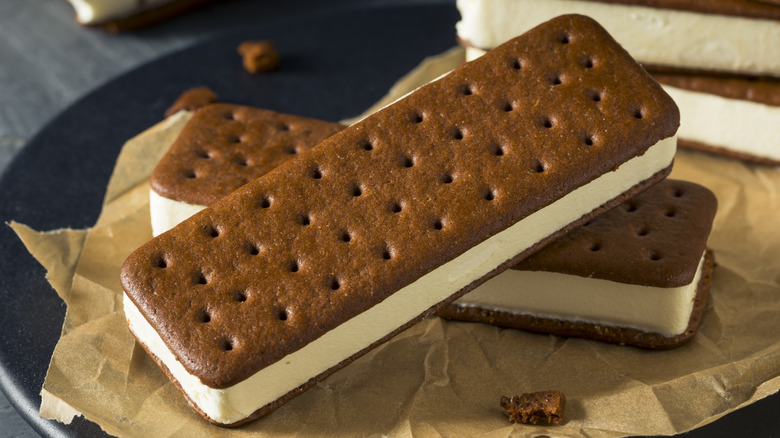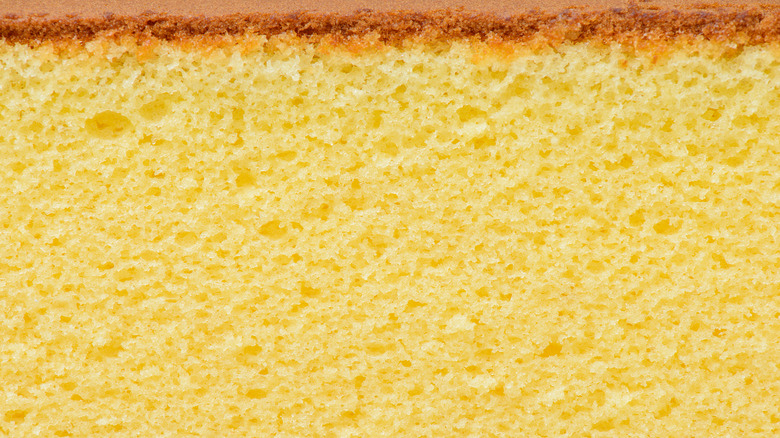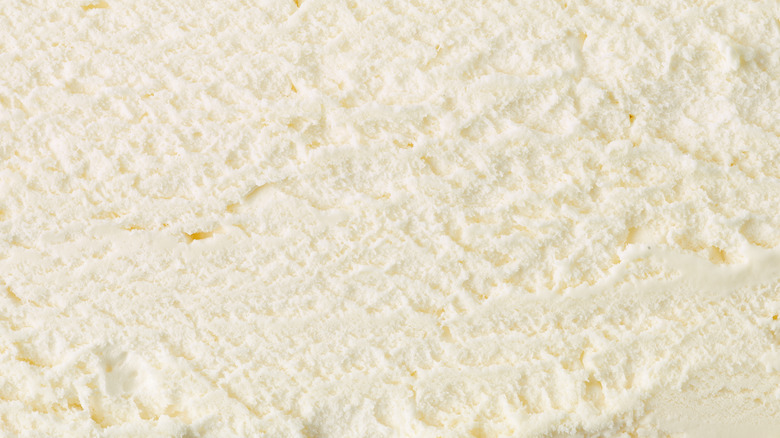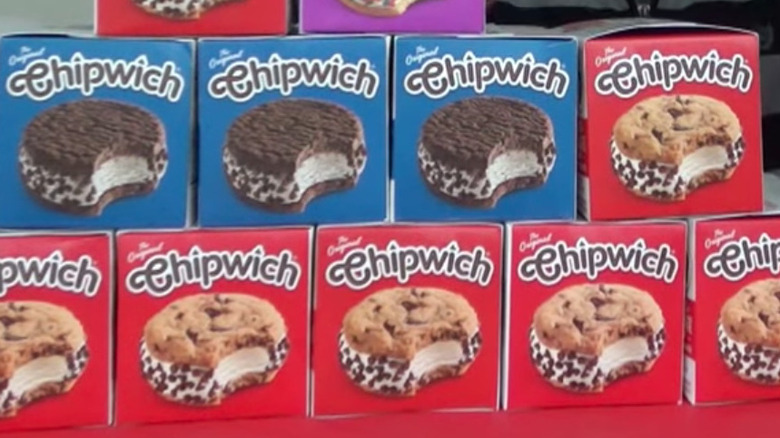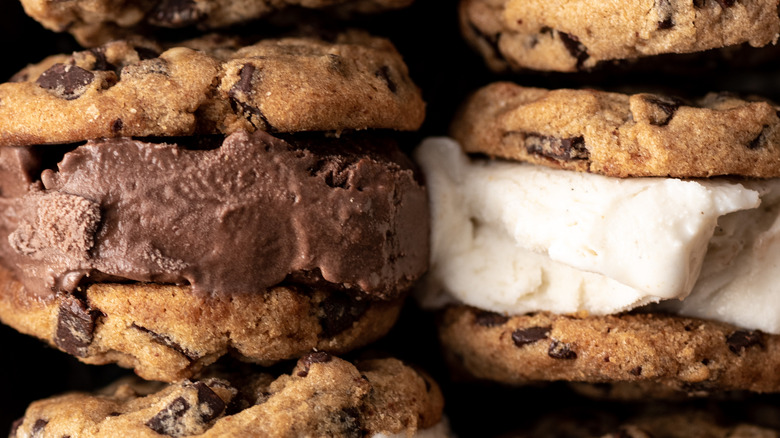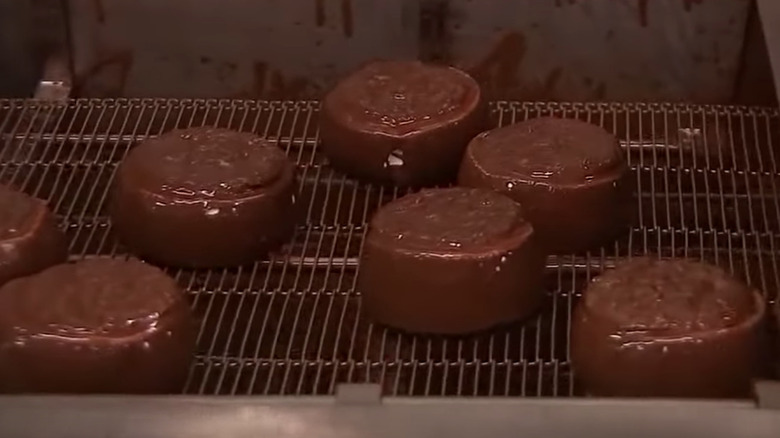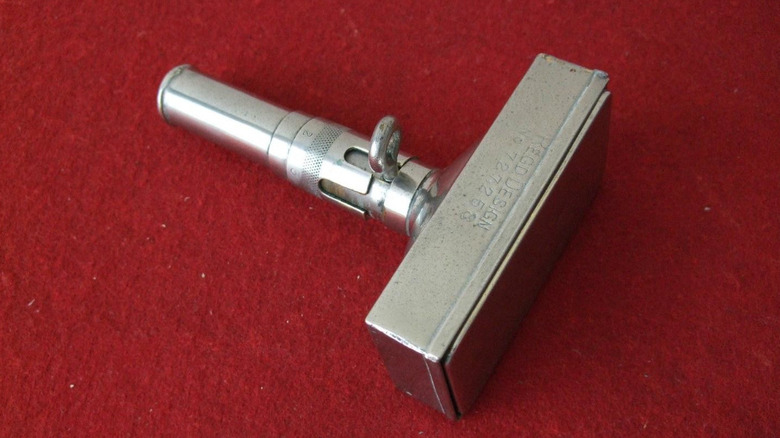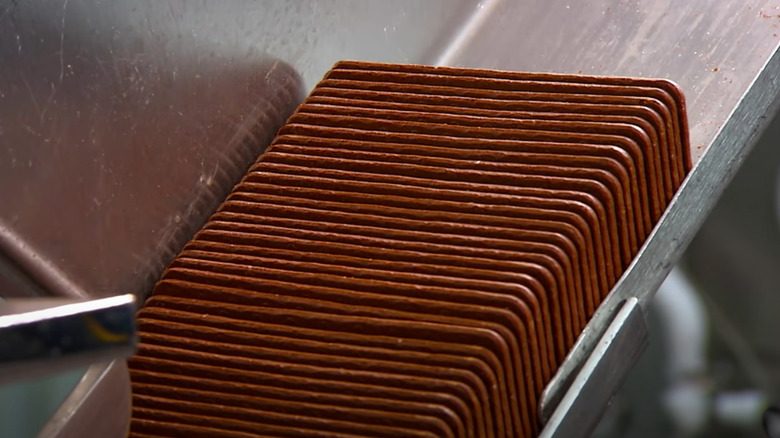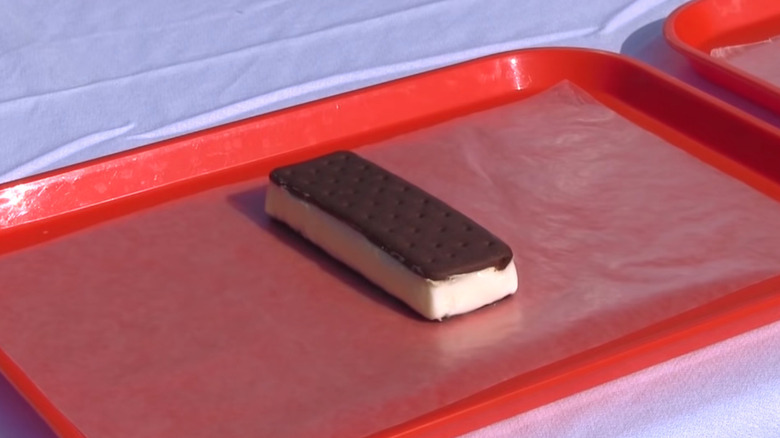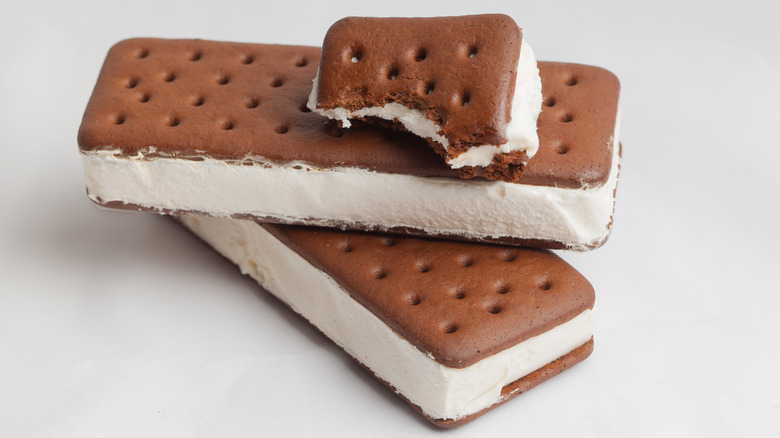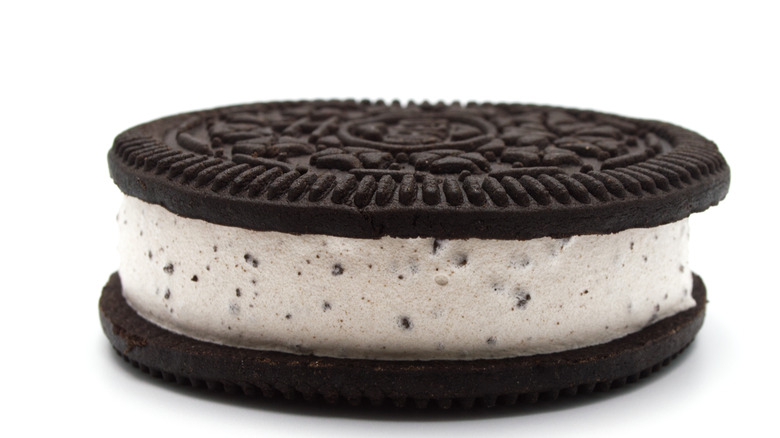Here's What You Never Knew About Ice Cream Sandwiches
Soft vanilla ice cream combined with two dense, chocolate wafers is culinary heaven. Maybe your memories of this little frozen rectangle are synonymous with that of ice cream trucks, corner stores, or boxes of store-bought sweets to eat at your own convenience. But this classic American treat has evolved since it was first made: wafers replaced by cookies; added dippings like chocolate, the sprinkling of chocolate chips, rainbow sprinkles, or nuts; and, of course, a revolving choice of ice cream flavors that aren't the classic vanilla.
Although these frozen treats have had their evolution throughout ice cream history, the chocolate-vanilla combination remains classic, and it has been that way for a while. But how did these come to be, and what were the very first versions like? Why did they become an ice cream novelty so quickly? There is more to these dessert squares than you might anticipate, so here's what you didn't know about ice cream sandwiches.
The first ice cream sandwich used paper instead of biscuits
You might be thinking, "How can a slab of ice cream wedged between two pieces of paper be an ice cream sandwich?" Well, this method was first seen in the late 1800s, according to Rochester First. Vendors with pushcarts sold these creations in New York City. Deemed "hokey pokeys," they sold for the price of a single penny.
However, they were not the size or shape you'd recognize now as an ice cream sandwich. In the shape of a square, they were about two inches wide, and a half an inch thick. The paper allowed customers to eat ice cream without getting their hands messy, according to Edible Manhattan. The paper made this ice cream snack portable, a revolutionary factor for something not traditionally eaten in this way.
And these frozen bites of joy became very popular. Vendors sold these treats so quickly that it is rumored they didn't have time to make change, so customers had to pay with a penny. Soon after in the early 1900s, a vendor in the Bowery neighborhood of New York City changed the game when he sold a similar item, but wedged between two plain biscuits, according to Frostbite Nitrogen Ice Cream. This closely resembled the modern-day ice cream sandwich.
Sponge cake and graham crackers were used to sandwich the ice cream together
After ice cream sandwiches had their run with the use of two slivers of thin paper, vendors experimented with sweet foods that differed in texture. Something would have to hold this portable ice cream treat together, and makers were determined to partner it with the best thing they could think of, and one that tasted right.
So what was next in line as the contender? Sponge cake, according to Rochester First, and you can probably guess how that went. Due to its porous texture and softness, it could not hold the ice cream together as it started to melt, rapidly absorbing the melted cream as a sponge would. With the problem of being too fragile, makers would need a stronger texture to ensure that thick cuts of ice cream could be supported, hand-held, and of course as mess-free as possible.
Naturally, a stronger sweet food was needed if this was going to work. Graham crackers were next in line, according to author Jeri Quinzio, and though they didn't quite make the cut, the concept of using a cracker-like sweet to hold ice cream together has stuck to this day. The chocolate wafers we use now are not all that different.
Ice cream sandwiches were a hit with Wall Street workers in 1899
Ice cream sandwiches aren't just the perfect symphony for the taste buds, they also have a history of bringing different classes of people together, according to Edible Manhattan. When the first ice cream sandwich hit the streets, it won the hearts of Wall Street workers, we learn in an article that ran in The Sun in 1900 a week after the first ice cream sandwich was sold (courtesy of Chronicling America.)
The article states, "This new edible made such a hit that its fame spread to the Wall Street district the first day and the young man who invented it did not have enough stock to satisfy the demand." It continues to describe the ice cream as "good" and that on the second day, "the brokers themselves got to buying ice cream sandwiches and eating them in a democratic fashion side by side on the sidewalk with the messengers and office boys." This popular street food became a favorite quick, sweet snack for people coming from different social classes.
Ice cream sandwiches were first mass-produced in 1945
The ice cream sandwich, in today's world a novelty sweet treat, came a long way from its humble beginnings. With a reimagined take on the ice cream sandwich yet again in 1945 (yes, our favorite dessert went through many phases), Jerry Newberg had another idea pushing the success of this confection even further, according to Frostbite Nitrogen Ice Cream.
Sticking to the traditional flavor of vanilla for the ice cream filling, Newberg's innovation on the ice cream sandwich was to add two chocolate wafers to hold it together. Previously, the wafers used before this were plain and served a utilitarian purpose rather than enhancing flavors. Selling these newly thought-up treats at Forbes Field to sports fans (the field was then the home of the Pittsburgh Pirates), Newberg's take on the classic treat caught on like wildfire; they were mass-produced later that year. We can humbly give thanks to Newberg for the modern-day ice cream sandwich.
Chipwiches were a hit
The culinary art that is the Chipwich has been satiating people for years. If you're confused about what sweet treat you're craving, why not enjoy ice cream with cookies and call it a day? In 1978, Richard LaMotta came up with his idea of a chocolate chip cookie holding a thick slab of vanilla ice cream and rolled in chocolate chips like a wheel picking up dirt (only a whole lot tastier). With a background in the business of ice cream, he perfected his treat in a basement in Brooklyn, according to SFGate.
Deeming it the "Chipwich," he sold 25,000 of them in Brooklyn in 1982 (courtesy of The Original Chipwich). Using 60 street-car vendors to let word spread and dollars rolling in, he sold them in just a few hours for one dollar each. Fast forward a couple of weeks, and Chipwich sales rose to 40,000 a day. That following summer Chipwich plants in Queens and New Jersey were turning out over 100,000 of this treat daily.
Eight years before LaMotta's death in 2010, he sold his company to Coolbrands International. By this time, over one billion Chipwiches had been sold to sweet-craving consumers. Now sold in three flavors, Chipwich has a birthday cake flavor with vanilla ice cream and sugar cookies with rainbow sprinkles, cookies and cream with chocolate cookies, and, of course, the original version that put it on the map (via their website).
The twist on the first ice cream cookie sandwich is debated
Despite the success of the 1978 Chipwich, the origin of the first ice cream cookie sandwich has been debated. With the IT'S-IT brand churning out their ice cream cookie sandwich 50 years prior to the Chipwich (via the IT'S-IT website) and experimentation with foods like sponge cake, it's difficult to assess where the credit is due (courtesy of SFGate). Does the credit belong to the very first attempt at a cake-like substance paired with ice cream? Though this being said, it does not count as a cookie.
Both IT'S-IT and Chipwich brands used cookies instead of the traditional chocolate wafers and inspired more cookie-ice cream combinations. Though years apart, IT'S-IT is the first known to have marketed its ice cream cookie product to attain huge success in California. While Chipwich also boasted tremendous success on the East Coast, perhaps we can say that each coast got its fair share of ice cream cookie success.
California's IT'S-IT changed the ice cream cookie game forever
On the West Coast of the U.S., San Francisco also has its own version of the ice cream cookie sandwich. The IT'S-IT Ice cream sandwich came about in 1928, created by George Whitney. Using two oatmeal cookies to compress a scoop of soft vanilla ice cream and later coated with dark chocolate, the IT'S-IT frozen treat was born, and so was the beginning of a new craze still enjoyed to this day (via its website).
Originally sold at Playland-at-the-beach in San Francisco, sales there lasted for around 40 years until the IT'S-IT brand relocated to a small shop, where each was handmade. San Francisco loved the product so much, the company opened an even bigger location in 1976.
At the IT'S-IT facility currently, around 100,000 ice cream sandwiches are produced every day, according to a Youtube video by KTVU. In terms of the process, 4,000 gallons of cream blended with milk are placed into a silo and then a pasteurizer, which are later dumped into a homogenizer. After it all cycles for 24 hours in a big tank, the mixture is blended with the flavor being used that day, some of IT'S-IT's most popular flavors including its original vanilla, mint, and chocolate.
Ice cream sandwich making tools have evolved with time
Ice cream sandwich makers weren't always the rubbery or plastic ones we see today you simply pop in the freezer. When the ice cream sandwich caught on, a new, faster way of making it was needed that hadn't been thought up yet. It wouldn't be enough to make them one at a time, and the ice cream sandwich still hadn't been mass-produced yet.
According to Edible Manhattan, one tool used to assemble the tops and bottoms of ice cream sandwiches was a contraption made of tin that created uniformity. It was an easier way to attach the sandwich cracker parts to the ice cream, and could churn out up to three of these frozen treats at a time. A patent was given in 1916 for this new invention.
We learn from The Folly that another small handheld machine was also a part of this frozen treat effort. Constructed of a rectangular, metal plate, a cookie wafer could be pressed in with some ice cream, and then another layer of wafer would finish it off. It could then be released by this small machine and produce uniform little ice cream sandwiches. You can imagine how nice it must have been to enjoy this treat in a less messy, sticky way.
The chocolate wafers are applied while still brittle
That soft, cloudy decadence that is that cookie-like thing holding ice cream sandwiches together? What is it made of? It has all of the flavors of a chocolate biscuit, and is a heavenly pairing with classic vanilla ice cream. But how is it able to hold this entire affair together?
Well, don't be fooled by the softness this wafer has. As we've seen in ice cream sandwich history, soft textures like sponge cake did nothing for the structural aspects of this treat. So how can a wafer this soft work like a charm? The secret — it isn't.
When the chocolate wafer hits your taste buds, it's mushy in the best way possible, attached to the vanilla ice cream filling, and often leaves marks of squishy chocolate on your fingertips. However, when the wafer is originally produced in an ice cream facility, it is hard. Brittle, like a cracker would be. It is made from chocolate cake ingredients, and placed on the conveyor belt in a plastic wrapping. Later, each is applied to opposite sides of a third of a cup of ice cream, which is released from an injection pipe in conveyor-belt fashion (via a Youtube video by Science Channel) at a rate of 140 ice cream sandwiches per minute. The ice cream is then able to soak up the wafer without letting it over-moisten, giving the ice cream sandwich that classic combination of textures.
Walmart's ice cream sandwiches have a history of not melting
You may have heard of Walmart's Great Value-branded ice cream sandwiches. You may have even had one here and there. What you may not have realized is that these iced treats have a history of not melting ... but it's ice cream, right?
A mother in Cincinnati noticed her son's Great Value ice cream sandwich did not melt when it was left outside overnight in 80-degree weather. The phenomenon did not go unnoticed, even attracting Cincinnati news attention. But confusing as this may be, there's an explanation. We learn from a Youtube video by Consumer Reports that when brought out in 100-degree heat and placed on a plastic tray, the ice cream sandwich was left unbothered for 30 minutes, and barely melted in an hour.
It was professionally assessed that gums found in the product make it last in the heat for longer than other brands of the same treat. The Los Angeles Times reports that less fat found in ice cream does make it melt more slowly, and this type contains minimal fats. Fewer fats can also mean a higher water content in the ice cream, further making it melt at a slower pace. Higher-quality ice creams will melt cleanly on the mouth as well. Stabilizers, guar gum, and mono and diglycerides help control the melting rate of ice cream.
The ice cream sandwich is the 2nd best selling ice cream novelty in the U.S.
Even the classic ice cream sandwich has experienced some renovation in flavor since its earliest days. Take the Hood dairy brand for instance, which boasts ice cream sandwiches in more varieties than vanilla ice cream with traditional chocolate wafers, including cookies and cream, double chocolate, mint chocolate chip, strawberry, and also mini square versions, according to their website. This gives plenty of options for people with different palettes who wish to partake in the ongoing ice cream sandwich craze.
This is why the ice cream sandwich is the second best-selling ice cream novelty in the United States, with ice cream bars coming in first (via Ice Cream Profits). And who makes up most of the population consuming these cold treats? People in the age group of 30 to 44 made up most of the ice cream sandwich-eating population, and 50 percent of the U.S.' ice cream sandwiches are eaten by those living in the Eastern part of the country, we learn from the South Florida Reporter. If you are a hardcore ice cream sandwich fanatic, there's even a National Ice Cream Sandwich Day every August 2nd (a good excuse to eat not one, but two.)
There are many innovations on the modern-day ice cream sandwich
With the introduction of ice cream cookie sandwiches, this made way for other ice cream sandwich-adjacent products. Take, for instance, the Klondike brand's Choco Taco, a folded wafer resembling an ice cream cone filled with ice cream and dipped in chocolate, which was discontinued in 2022 to meet increasing demands for other Klondike products, according to CNN. Fans of the Choco Taco were so disappointed that the brand considered bringing it back.
Partially due to the change in ice cream sandwich culture after the first ones came out, these became desserts featured in upscale restaurants and eateries, we learn from Edible Manhattan. They were not the same as the kinds sold on the streets, some had to be eaten with forks on plates. Now, elevated ice creams can be found in store-bought ice cream sandwiches, like Tillamook's gelato sandwich made with waffle cones instead of wafers, and gelato instead of traditional ice cream (courtesy of Kroger). The makers of Oreo also offer a frozen version of this treat as an ice cream sandwich; think of the flavors in cookies and cream. If this is all you can think about, go ahead and try this ice cream cookie sandwich recipe!
